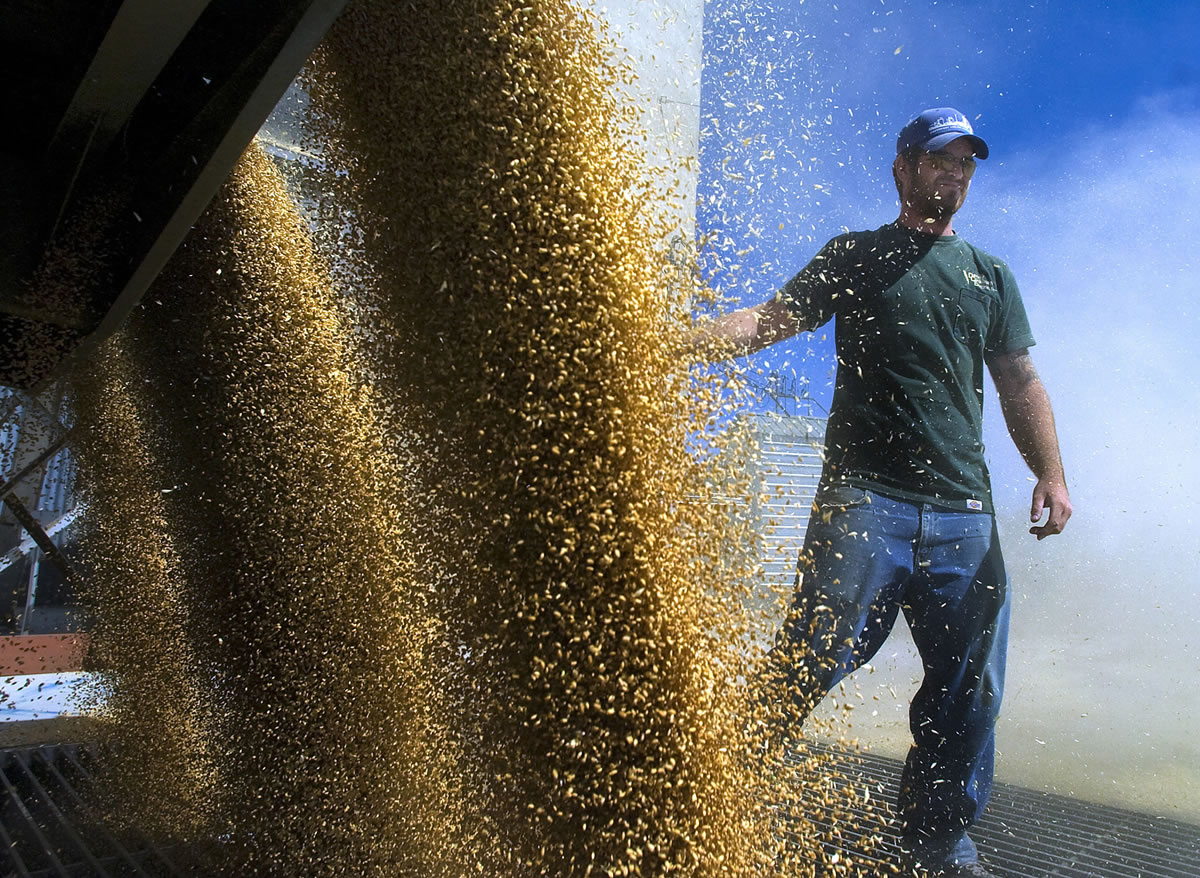OAKESDALE — Dick Schu’s weathered hands grip the controls of his combine, his left on the wheel and his right clutching the gearshift as he slowly descends a hill on his Whitman County farmland.
Farther up the hill, his son Ryan drives another harvester. The header is spinning a bit low as dust kicks up from underneath.
“Looks like I did a little excavating there,” Ryan’s voice crackles over the CB radio.
Dick Schu smiles. He has been harvesting the undulating golden hills of the Palouse since the 1960s.
And again this year, he and other Eastern Washington wheat farmers have much to smile about. The Spokesman-Review reports commodity prices are high for the fifth consecutive year, and acreage yields remain at near-record levels.
Yet the grain industry continues to weather uncertainty brought about by a genetically modified crop scare that temporarily cooled the international market for American wheat, as well as congressional inaction on a long-term farm bill.
More than three-quarters of the wheat threshing beneath Schu’s feet will be sold overseas, according to historical Washington state sales figures.
“So much of it is not used here,” Schu said as golden stalks crumpled beneath his harvester, spewing dust into the hot summer air. “We’re really dependent on our foreign markets.”
Those markets dwindled when Korea and Japan, the two largest purchasers of American soft white wheat, announced in May they would suspend business until the government investigated a genetically modified crop strain, resistant to weed killer, discovered in Oregon. According to the United States Department of Agriculture, the two countries with diets heavy in noodles, a staple end product of milled white wheat, bought about 40 percent of the soft white wheat exported in 2012.
After a probe discovered the modified wheat was isolated to a single farm, both countries announced tentative plans to resume buying. That’s good news for growers throughout Eastern Washington, which
produces about 41 percent of the nation’s white wheat crop annually, according to the Washington Grain Commission.
It’s especially good for farmers such as the Schus, who grow wheat on 1,500 acres. The small size of their family operation on land leased from a pair of Spokane sisters makes price fluctuations particularly painful. With one harvesting combine on the fritz, the family is depending on prices staying favorable in order to replace it with used equipment.
“I think that’s the crisis of the small farmer,” Schu said. “All of our equipment is getting older.”
Ryan Schu drove a standby John Deere combine last week as his family entered its second week of harvest, scheduled to finish up toward the end of the month. The harvester, manufactured in 1979, lacks reliable air conditioning and Ryan Schu is drenched with sweat when he climbs from the cab on a break.
“That’s a ’79, and I was born in ’80,” Ryan Schu said, pointing at his rig with a grin. “You don’t see much of anything ’79 driving around anymore.”
The Inland Northwest has been blessed with a good crop this year, farmers along the Palouse will tell you. Dick Schu said some rains in late May and June were a “godsend” to parched fields. Early crops displayed very little dockage, a quality measure of harvested wheat used by inspectors that quantifies the amount of chaff, stems and immature grain kernels that make it into silos.
But heavy rains at the beginning of August have plagued subsequent samples from the eastern side of the state, said Don Potts, regional grain inspection manager with the Washington Department of Agriculture.
“The quality went from excellent to slightly below average,” Potts said Wednesday.
‘Nice and fat’
Two workers at the McCoy grain elevator between Oakesdale and Rosalia, where the Schus drop their harvest, said early returns look promising. Billy Reed and Scott Gortsema sweep the dry kernels of a dozen area growers into a chute nonstop for 13 hours each day, handing truck drivers slips telling them how much grain they’ve deposited.
“The grain’s coming in clean; it’s coming in nice and fat,” said Reed, who returned to the job after a stint in the military.
Two of his customers are Dick Schu’s daughter, Shelly Beach, and her 12-year-old son, Noah. She has been driving loads of grain, totaling around 10 tons each trip, from her father’s combine to the elevator for 28 years. One of the trucks in which she learned to drive is still in use on the farm; the other went up in flames about a decade ago when mice gnawed through wires and started an electrical fire. Shelly and her husband, both volunteer firefighters, responded to the fire call.
“It’s hard when it’s only me out here,” Shelly Beach said. But her daughter, who’s 14, will be filling in for her in the driver’s seat soon.
For all the talk of weather, acreage and acts of God affecting the crop this year, there’s little mention of the federal farm legislation that has stalled on Capitol Hill for the second straight summer. Growers say federal support is important as the costs of maintenance and insurance rise, but the day-to-day operations here remain mostly unchanged by the whims of Congress.
White wheat still grows the best on the Palouse, Dick Schu said, and he wouldn’t change his ways unless something dramatic is handed down by lawmakers. He’s having too much fun riding the hills with co-workers he’s trained since birth.
“They’ve been doing this long enough, they know what they’re doing,” Schu said



